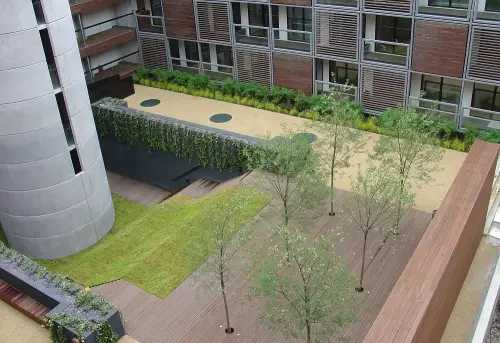Our country pages
Africa
Europe
Search
Green roof
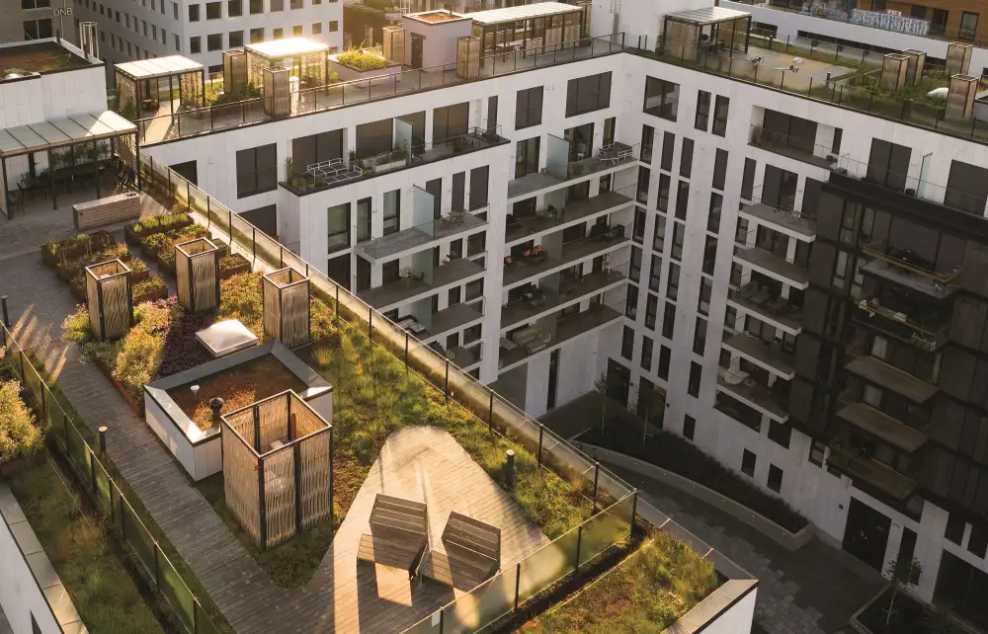
What is a green roof?
Whilst looking at roofing solutions for your buildings, you’ve probably come across green roofs. This eco-friendly roofing system is just as sustainable as it is aesthetically pleasing - and it should absolutely make your shortlist when it comes to reviewing viable options for your buildings and in your space planning.
Put simply, a green roof is exactly as it sounds. It’s a flat to low pitched roof (no more than 30 degree pitch) that is covered in vegetation and fauna. Predominantly, the surface is composed of plant and soil layers, which help to absorb water and reduce run off, as well as adding an additional insulation layer for the roof.
Whilst green roofs have existed for centuries, they have certainly increased in popularity over the past few decades as more and more businesses move towards corporate social responsibility to counter the decline of green and biodiversity spaces in urban areas, such as cities. It's not unusual these days for city planners.
It’s likely that the surge in demand for green roofs will continue. Paris, for example, has now made it mandatory by law for the roofs of all new commercial buildings to be covered completely or partially with plants or solar panels.
To speak to someone for help and advice about your project design, specification and budget or for information about site inspections and maintenance programs, please email us.
What are the benefits of a green roof system?
What are the benefits of a green roof system?
The great thing about green roofs is that they tick so many boxes for sustainability, technology and aesthetics. If you’re investing in a green roof, it’s important to know exactly what the benefits are so that you get a great return on investment:
Roof membrane protection - vegetation on a roof deck protects the roof surface from the extremes of weather, temperature and UV radiation, which can significantly prolong its life
Reduced storm water run-off - water is stored by the green roof substrate and then taken up by the plants, where it is returned through transpiration and evaporation into the atmosphere. The drainage layer in green roofs also delay the rate at which water run-off occurs, resulting in decreased stress on drains and sewers during periods of heavy rainfall
Reduced energy costs - The layers of a green roof system are able to improve the thermal performance of the roof, helping to keep the rooms below cool in summer and warm in winter, although this effect is generally not included in any uValue calculations
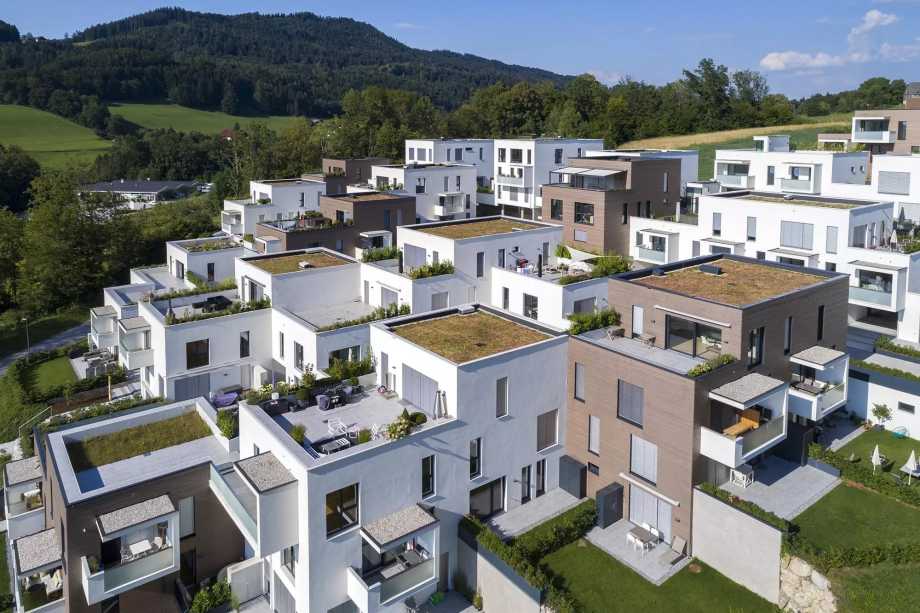
Sustainability benefits of a green roof
Alongside the benefits to your pocket, you might also be considering a green roof solution to help improve your business’s carbon footprint, or simply because you’d like to create a space that is more environmentally friendly than other roofing systems. A green roof can:
Encourage wildlife habitats - Rooftop habitats can provide a “green link” connecting natural pockets of habitat with each other. They can also provide isolated habitats, which aren’t disturbed by other green areas at ground level
Improved air quality - Green roof planting will improve air quality by absorbing atmospheric carbon dioxide and releasing oxygen
Improved temperature regulation - Through the daily cycles of condensation and evaporation, plants are able to cool and humidify the surrounding air, which improves the micro-climate
Types of green roof systems
Whether you’re planning a green roof installation for practical or aesthetic reasons, there are several types of green roofs that you might like to consider.
Intensive green roofs
Intensive green roofs
Intensive green roofs provide for the heaviest layers of vegetation - so much so, they’ll host shrubbery, deep planters and even trees. Because of this, access to this roof is key, as it will require maintenance to keep the green roof in top condition.
They predominantly have a build-up depth of around 300-1000mm, and will need regular irrigation throughout their lifespan (you can have these systems installed too). A key consideration whilst looking at the installation of an intensive green roof is whether the roof slopes - this can mean that your building is not suited to an intensive solution, unless terracing is designed as a means to cope with this.
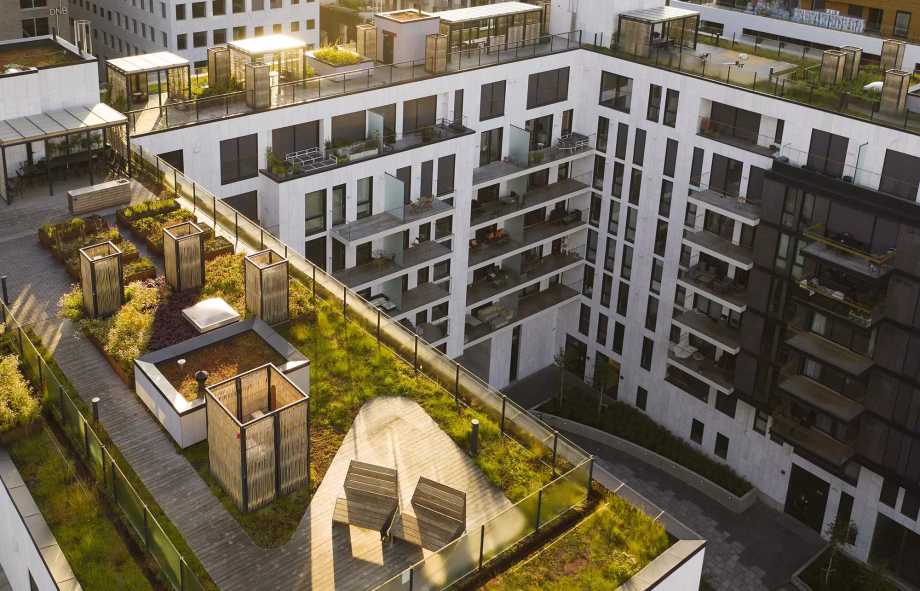
Semi-extensive green roofs
Semi-extensive green roofs
As the name suggests, a semi-extensive roof falls somewhere in the middle of an intensive and extensive green roof in terms of depth and weight. They might be preferential for roofs that have too much of a slope for an intensive version, but where you’d like more variety and environmental benefits than you might get with an extensive green roof.
If you’re unsure what type of green roof would be most suitable for your property, our experienced team are on hand to offer tailored advice on a roofing solution for you - just get in touch with us at rethinkroofs@bmigroup.com.
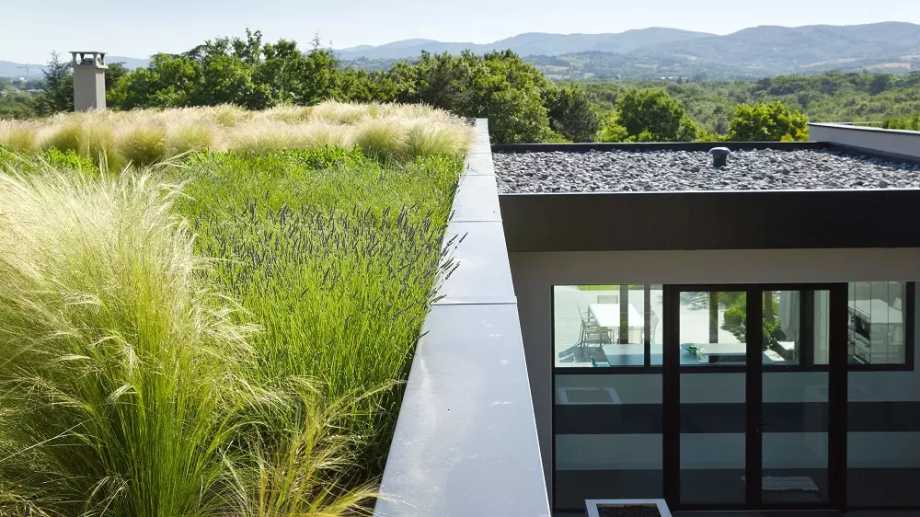
Extensive green roofs
Extensive green roofs
Extensive green roofs are the lighter weight solution of the three options. This means that the substrate layers of plants and soil is thinner than it would be on an intensive or semi-extensive green roof.
The standard set up for an extensive green roof is to layer up drainage and filtration layers over which the growing medium is laid and then the living layer on the top, which is generally composed of low growing grasses and sedum. The result is a low maintenance roof usually coming in at a thickness of between 80-300mm. The shallowness of the extensive system means that it has lower water attenuation than an intensive system.
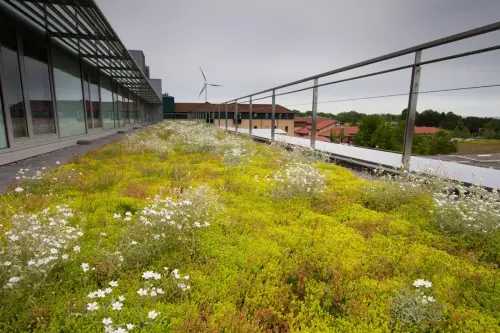
Green roof construction
All green roofs have a number of vegetation options available, depending on whether you opt for an intensive, extensive or semi-extensive option. For example, with our Canopia extensive green roofs you’ll have the option of establishing the greenery with either;
Vegetation mats - a simple solution to creating a green space quickly, with this layer delivered directly on top of the substrate
Plug plants - this method allows great flexibility in the variety of fauna installed on the roofing system. They can be more cost effective than a vegetation mat, but will take longer to grow
Seed - The slower of the vegetation options, this is simply the method of sowing seeds directly into the substrate, and is often done in conjunction with plug plants
Our large portfolio of products means that we’re able to supply the correct, unique solution for each individual roof. If you’d like to learn more about our products, you can download our green roof brochure or get in touch with us on rethinkroofs@bmigroup.com
Creating a green haven for pioneering apartments
